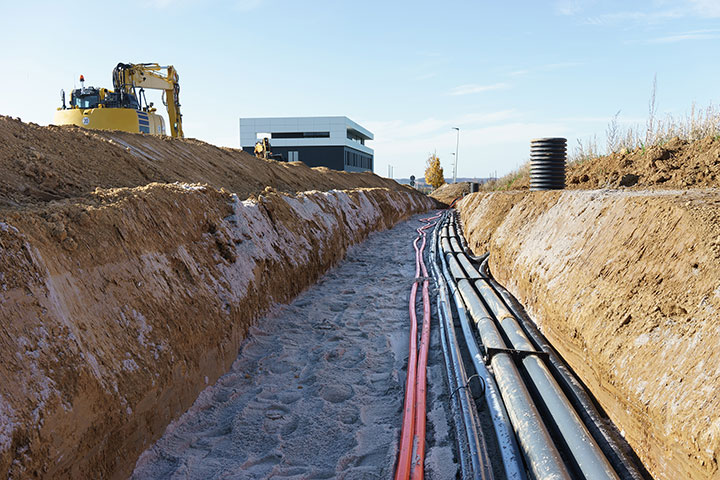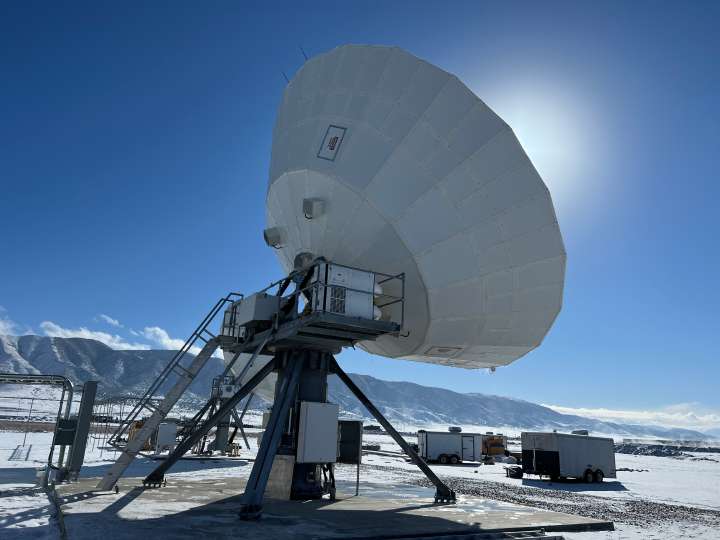 The Broadband Equity, Access, and Deployment (BEAD) program will provide $42.5 billion in funding to U.S. states to build out high-speed broadband to unserved and underserved locations.
The Broadband Equity, Access, and Deployment (BEAD) program will provide $42.5 billion in funding to U.S. states to build out high-speed broadband to unserved and underserved locations.
ALEXANDRIA, Va. — It seems like a simple enough question: What role will satellites play in the recently announced $42.5 billion broadband funding program to help close the digital divide in the United States?
From a technological standpoint, today’s satellite broadband offers anywhere connectivity, high speeds and high throughput. From a cost perspective, the price per Gbps is almost half what it was a decade ago, while fiber costs have been rising.
Yet, satellite has received only a tiny portion of state and federal subsidies to connect the unconnected in hard-to-reach places. With technologies advancing and the number of satellite broadband subscribers growing, the question becomes: why?
The BEAD Opportunity
At the end of June, the Biden administration announced the Broadband Equity, Access, and Deployment (BEAD) program, with $42.5 billion to be allocated to states and territories to invest in quality, affordable, high-speed internet. The National Telecommunications and Information Administration (NTIA) will administer the program in coordination with state broadband offices.
Over the next year, states will submit initial proposals that prioritize unserved areas, with no broadband service or speeds below 25/3 Mbps, and underserved areas, defined by speeds of 100/20 Mbps. Service will also have to meet a new latency requirement of no greater than 100 ms. Qualifying proposals should maximize affordable service while minimizing the program subsidy required and considering the time required to deploy the network.
Satellite Industry Association President Tom Stroup noted that satellite technology could be a good fit for the program. Current generation LEO and GEO satellites can meet the speed and cost parameters and rapid network deployment time. Latency requirements, however, could exclude otherwise viable satellite technologies.
“On a technical basis, I think we absolutely can compete with most of the other services,” said Stroup. “Some of our members, certainly, are engaged in different states to participate and I expect they’re going to submit proposals to qualify for the funding.”
Viasat recently suggested it could be interested in the program. Light Reading reported the company was in touch with federal and state officials to apply for funding and was optimistic about ViaSat-3’s ability to deliver capacity nationwide.
It’s unclear which LEO broadband providers will apply, particularly after the FCC’s controversial ruling to reverse a nearly $1 billion rural broadband subsidy to SpaceX’s Starlink last year.
Combatting the Fiber Bias
Agencies like the FCC and NTIA have often maintained that they are “technology neutral” in awarding funding for broadband programs. Many times, the nature of the programs and legacy interests tend to favor fiber over other technologies. This has been a concern for satellite companies that are considering applying for funding.
“I think there’s a real fear that there is a fiber bias,” Stroup noted.
SIA continues to work with policymakers and regulatory agencies to combat any impartiality and ensure broadband satellite is included in state and federal broadband programs. “I think we’re making a lot of progress in terms of increasing awareness of the satellite industry’s capabilities,” Stroup continued. “We try to be candid when we can about the way the programs are being implemented.”
 Approximately 7% of the U.S. population is unserved, according to the FCC. Satellite broadband is an attractive option for remote, rural, high-cost areas where fiber is not a viable solution.
Approximately 7% of the U.S. population is unserved, according to the FCC. Satellite broadband is an attractive option for remote, rural, high-cost areas where fiber is not a viable solution.
The NTIA has said that broadband satellite internet would not be excluded from the BEAD program. An agency official acknowledged that “significant portions” of funding will likely go to satellite and other technologies where fiber is cost-prohibitive. Under a provision of BEAD, states will be permitted to set an “Extremely High Cost Per Location” threshold that could open the door for satellite broadband solutions.
At the same time, draft guidance encourages states to “prioritize projects designed to provide fiber connectivity directly to the end user.” Moreover, the NTIA designated areas served solely by satellite as unserved. According to some critics, this designation will direct states to overbuild infrastructure in areas that already have service.
“I think there’s a breakpoint at which it makes sense to go to fiber optics,” explained Karen Jones, senior project leader in the Center for Space Policy and Strategy at The Aerospace Corporation. Population size, proximity to terrestrial infrastructure, even latitude can affect that balance. “But [fiber] is not practical for every place on the planet. When you start to look at some of these rural areas, satellite needs to be part of the equation.”
Fiber has clear benefits for speed, reliability, bandwidth and minimal signal loss. But for a portion of the 16 million unserved and underserved Americans, satellite could represent a better option in terms of cost and immediate availability. According to one study, a fiber-only approach to connect the entire United States would cost around $200 billion, or more than five times the total amount of the BEAD program. Fiber costs have also gone up 70% globally in recent years due to inflation, supply chain disruptions and labor shortages.
Low-Latency Intended to Exclude Satellite?
There continue to be questions about BEAD’s latency requirement and whether it was intended to exclude GEO operators. The NTIA did not respond to multiple requests for comment. The requirement seems to have originated from language in the 2021 Infrastructure Act which called for “a latency sufficient to support real-time interactive applications.”
Certainly, latency below 100 ms will be a bigger hurdle for geosynchronous operators than those in low Earth orbit. A typical LEO satellite experiences between 25-50 ms of latency. A GEO can have anywhere from 400-900 ms of delay. Both solutions offer upload and download speeds that meet or exceed BEAD requirements.
Stroup emphasized the ongoing improvements in satellite broadband speeds, throughput and costs. At the same time, he urged against regulatory requirements that “don’t necessarily have a basis in user needs but can preclude industries, like the satellite industry, from participating in funding.”
There are important use cases that require latency below 150 ms, including video conferencing, voice over IP applications and many real-time web connections. The majority of internet traffic is not latency sensitive, and speed and throughput tend to be more decisive for network performance.
In addition to questions about its intent, the latency requirement also emerged at a time when satellite technology has been increasingly competitive in broadband funding awards.
Backlash to Satellite Awards
Satellite broadband was still in its infancy when the U.S. invested $7 billion in closing the digital divide through the 2009 American Recovery and Reinvestment Act (ARRA). According to reporting at the time, dozens of satellite providers bid for $2.2 billion of program funding. Just four were awarded $100 million in loans through the Agriculture Department’s Rural Utilities Service.
By 2020, performance and cost had improved significantly. During an FCC Connect America Fund Phase II (CAF II) auction, Viasat shocked traditional broadband providers, winning $122.5 million in awards for projects in 20 states. The auction was technology agnostic and based on a competition for the lowest cost service, short deployment time and fast network speeds. Viasat won the awards despite a weighting system that penalized high-latency services in the bidding process.
Later that same year, Starlink emerged as a big winner in the $9.2 billion Rural Digital Opportunities Fund (RDOF) reverse auction. The LEO operator was awarded $885 million in rural broadband subsidies through the FCC’s Universal Service Fund to connect nearly 650,000 locations in 35 states. The FCC ultimately clawed back the full amount in 2022, claiming Starlink’s satellite internet service was “promising” but had not delivered the promised speeds to “meet program requirements.” SpaceX appealed the decision saying it will meet required speeds by 2025, in line with RDOF service milestones. The issue remains open.
Satellite providers’ success demonstrated the technology’s competitive advantage in connecting hard-to-reach areas. The infrastructure has proven more cost-efficient than extending fiber to certain locations and, when on-orbit capacity is available, new subscribers can begin receiving service almost immediately, instead of waiting years to lay cable.
 Pacific Dataport antenna serving built to support rural broadband throughout Alaska Astranis MicroGEO satellite. (Source: Kratos)
Pacific Dataport antenna serving built to support rural broadband throughout Alaska Astranis MicroGEO satellite. (Source: Kratos)
The wins also prompted blowback from historic subsidy recipients, like small, local broadband providers, that have advocated for programmatic changes to protect their position against displacement and being underbid by new technologies, like satellite.
“I think it’s instructive to see the reaction after each time satellite has significant success,” explained Patricia Cooper, a satellite industry veteran and President and Founder of Constellation Advisory, LLC. “There are legacy businesses that are highly invested in program requirements that allow them to retain their share of supports.”
The issues of speed, capacity and cost will remain favorable considerations for satellite providers in the coming years, particularly where fiber buildout is more costly with lower relative returns. According to SIA’s latest report, GEO capacity is expected to triple by 2026 and LEO approaches 200 Tbps. Meanwhile, the cost per Gbps to manufacture a satellite has dropped 90% in less than a decade.
Keeping an ‘Eye on Technological Horizon’
There will be a multi-step process states have to follow before the money starts flowing. Funding amounts for each state and territory were allocated based on connectivity levels reflected in the FCC’s Broadband DATA Maps. Eighteen states are slated to receive more than $1 billion through the program, including California Missouri, Michigan, North Carolina, Virginia, Alabama and Texas, which could get more than $3.3 billion.
Over the next year, state broadband offices will submit initial broadband proposals and set their Extremely High Cost Per Location Threshold, which will determine when non-fiber options, like satellite or fixed wireless, are justified.
In light of evolving satellite capabilities, Jones urged regulators and BEAD recipients to keep an “eye on the technological horizon.”
Markets can and have undergone dramatic technology changes in a matter of years, Jones said, citing the rapid shift in transatlantic communication from satellite to undersea cables. “It points to the dynamic nature and the very quick way markets can turn based on technological advantage,” she noted. “That’s why I would hope regulation remains technology neutral, so that they can be open to technological progress and emerging technology breakthroughs.”
Other experts have suggested revisiting the structure of broadband funding programs, many of which are modeled on the rural electrification program of the 1930s. Depending on the openness to new technologies and new players, there could be more beneficial partnerships between legacy rural cooperatives and new space companies. The Pacific Dataport project in rural Alaska is typical of such collaboration.
Despite the hurdles satellite technology has faced in federal broadband programs, Stroup said he believes it’s “worthwhile” for satellite providers to consider bidding for the program.
“We’ll find out more throughout the year as we see states making the awards,” he noted. “My expectation is that this is not the last we’re going to hear of broadband funding programs...This is going to be a continuous effort and it has been for a number of years.”
Explore More:
Podcast: Software-Defined MicroGEO, Integrated Ground and a Network for Rural Alaska
What Happens When You Triple On-Orbit Capacity?
New Forum Highlights Wireless-Satellite Opportunities
Podcast: 5G, Satellites and Connectivity Anywhere
